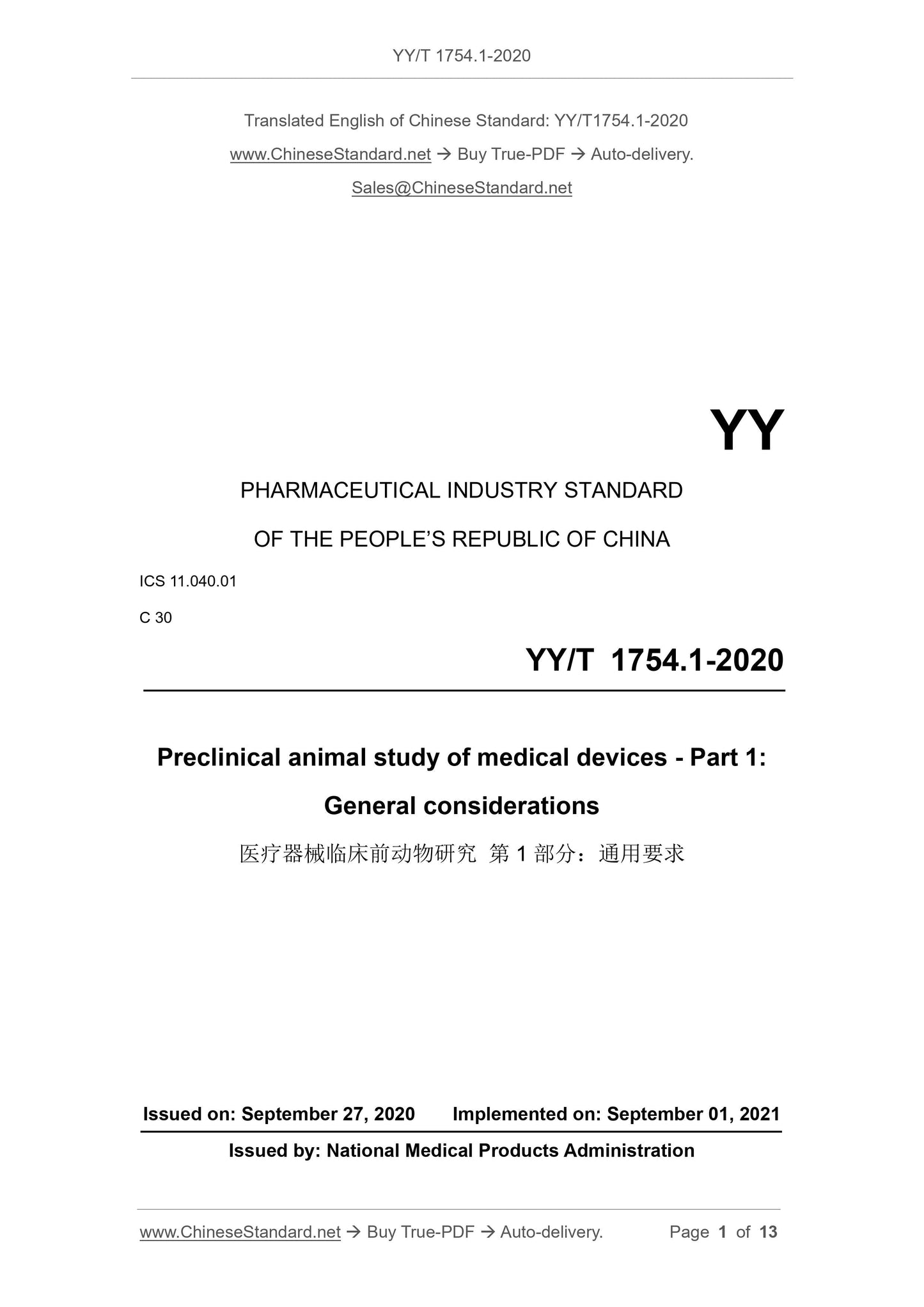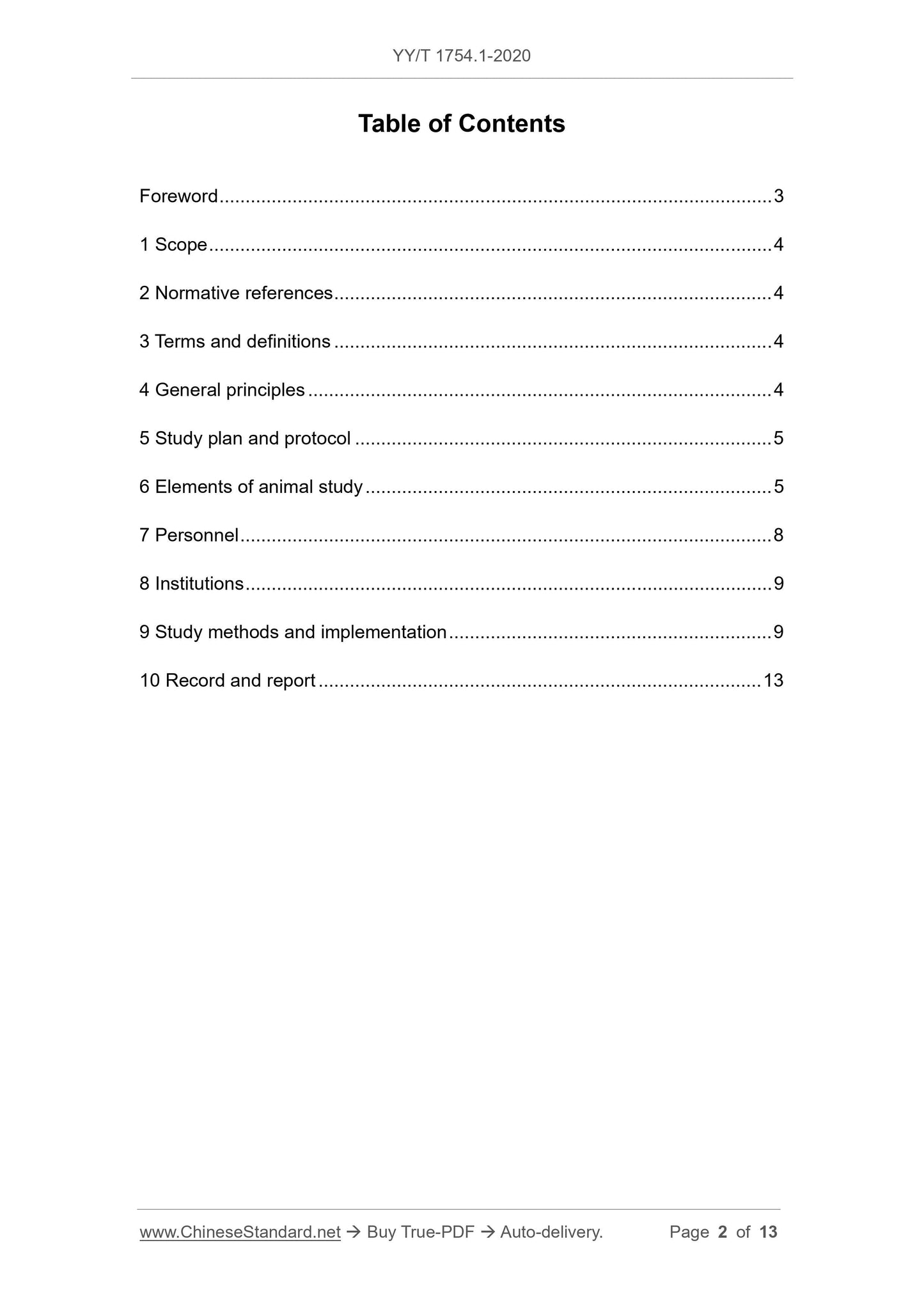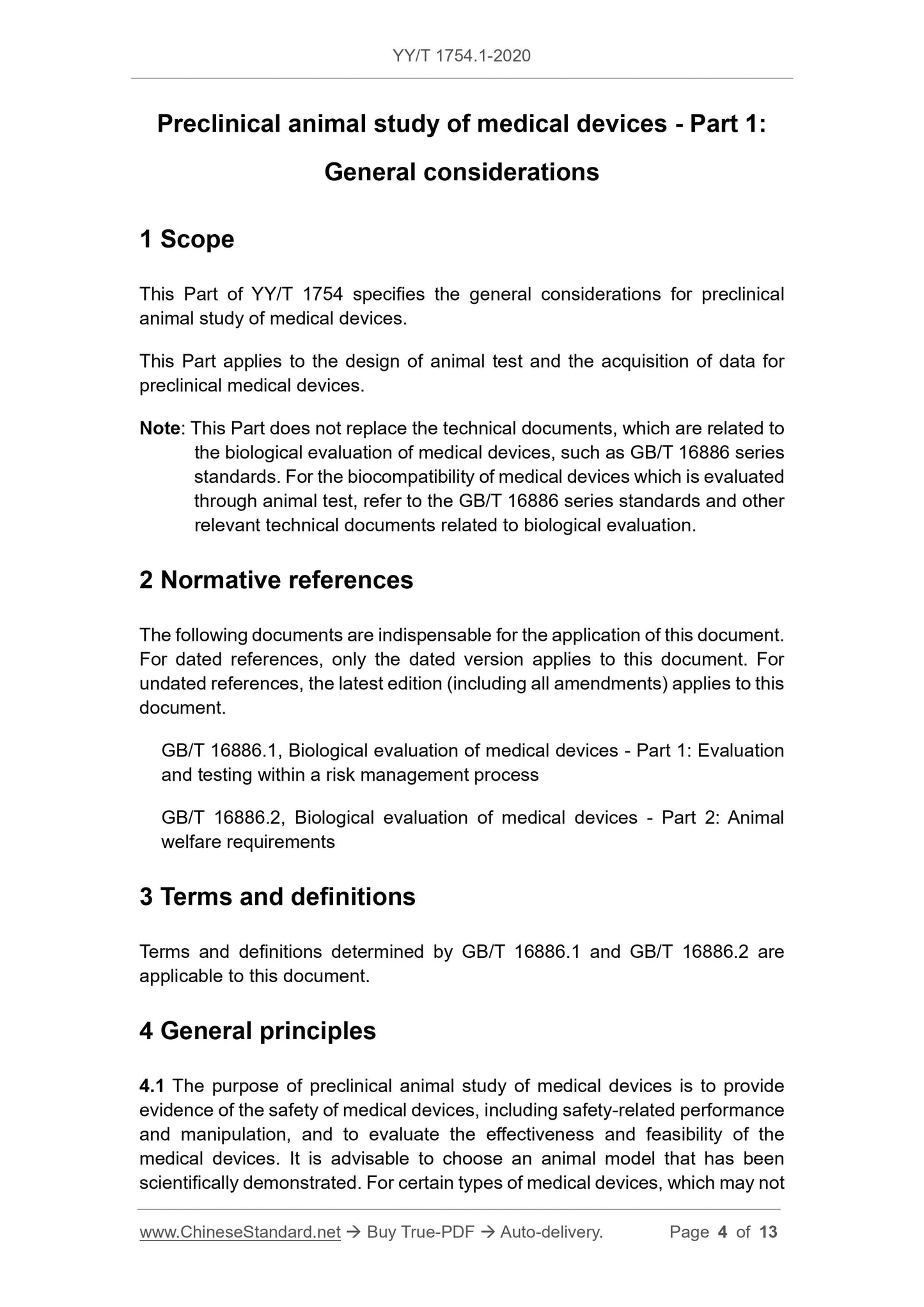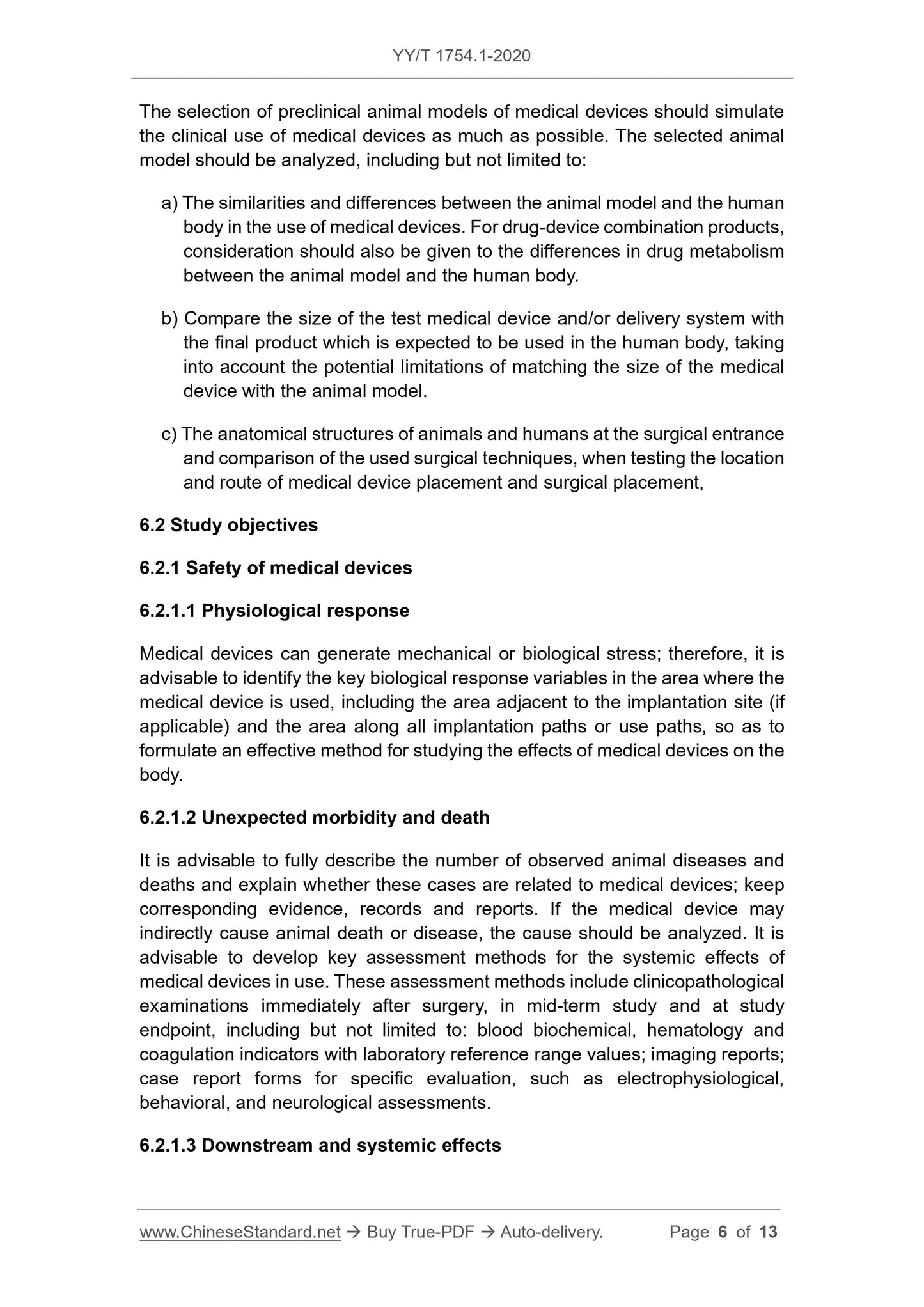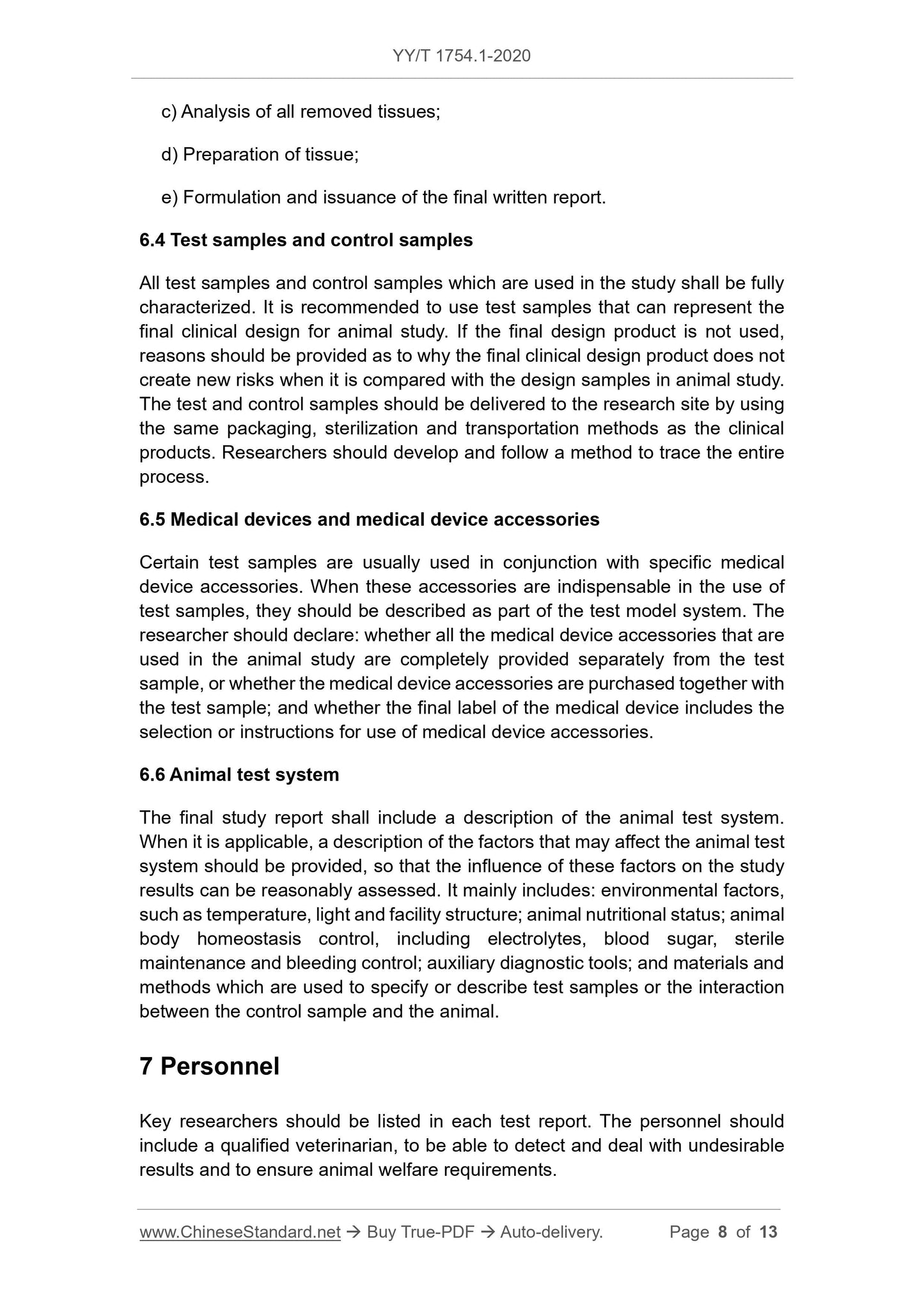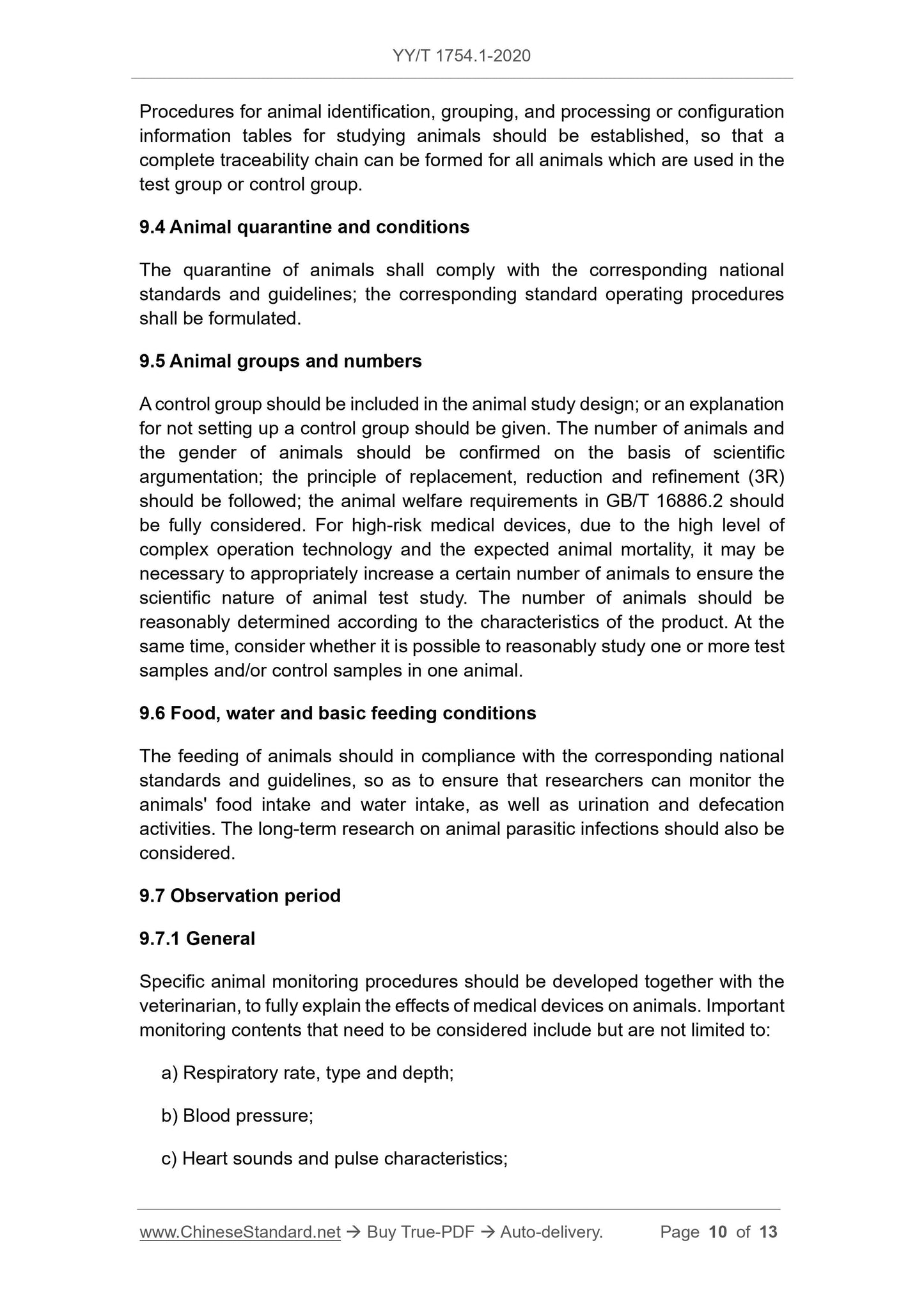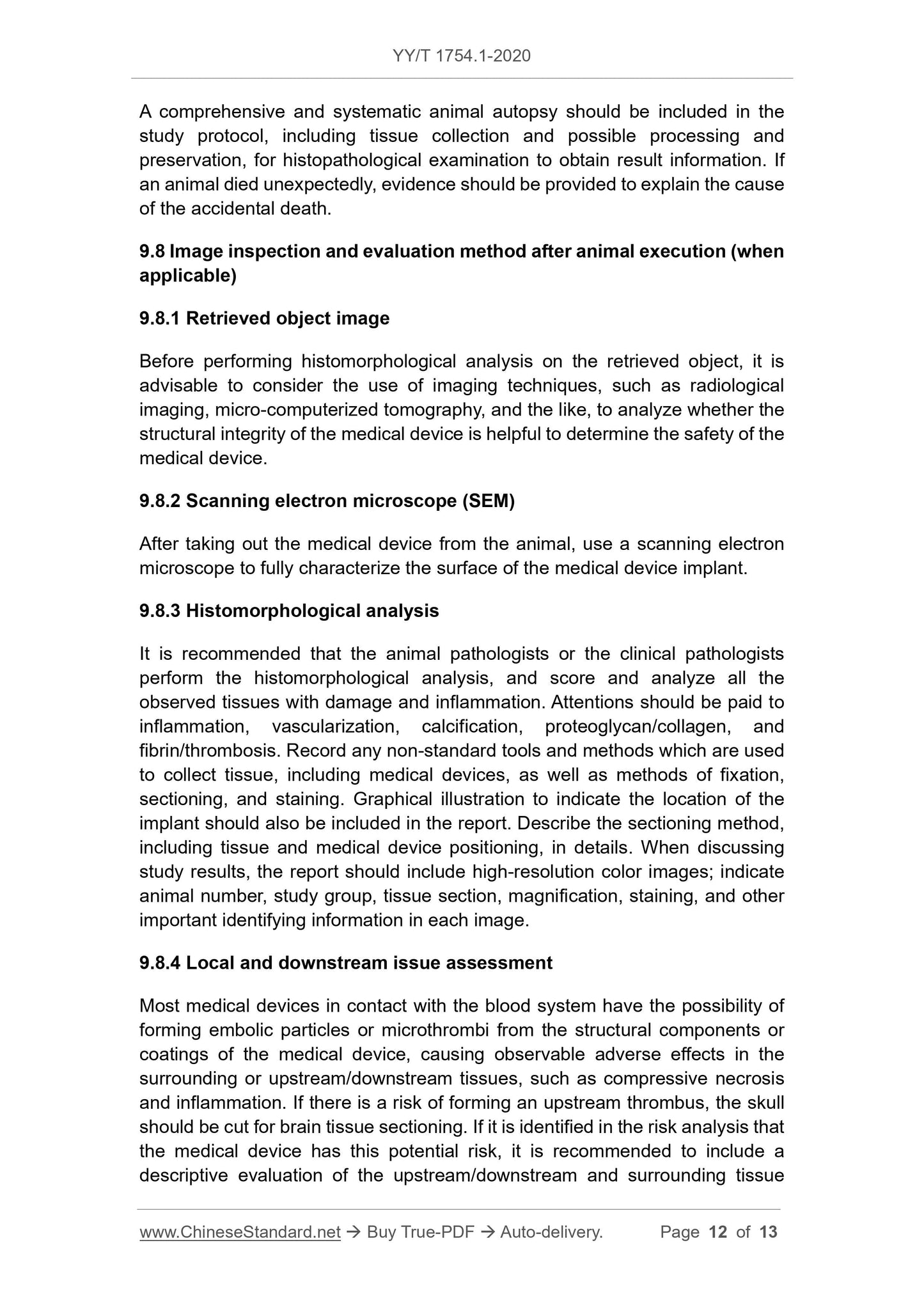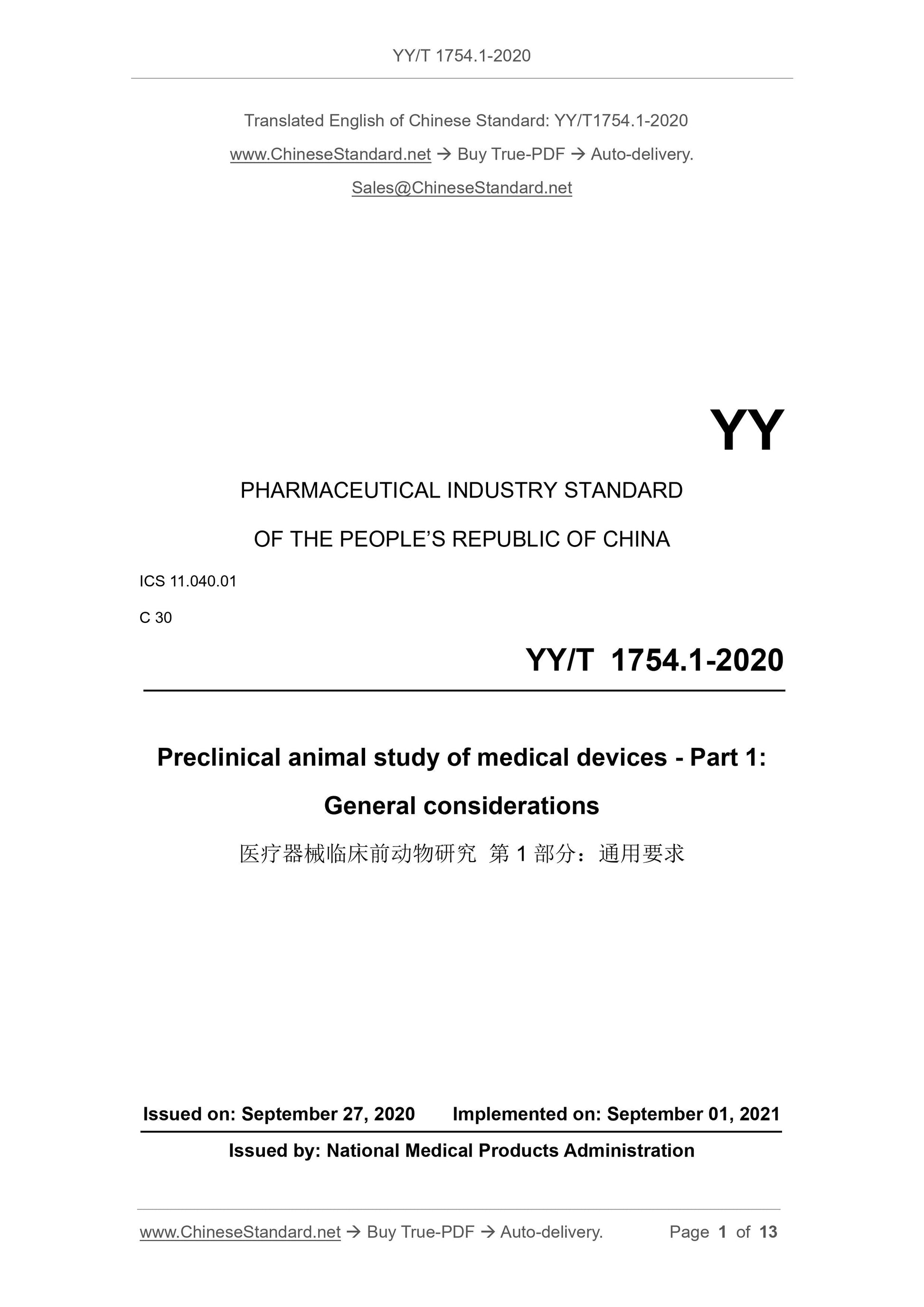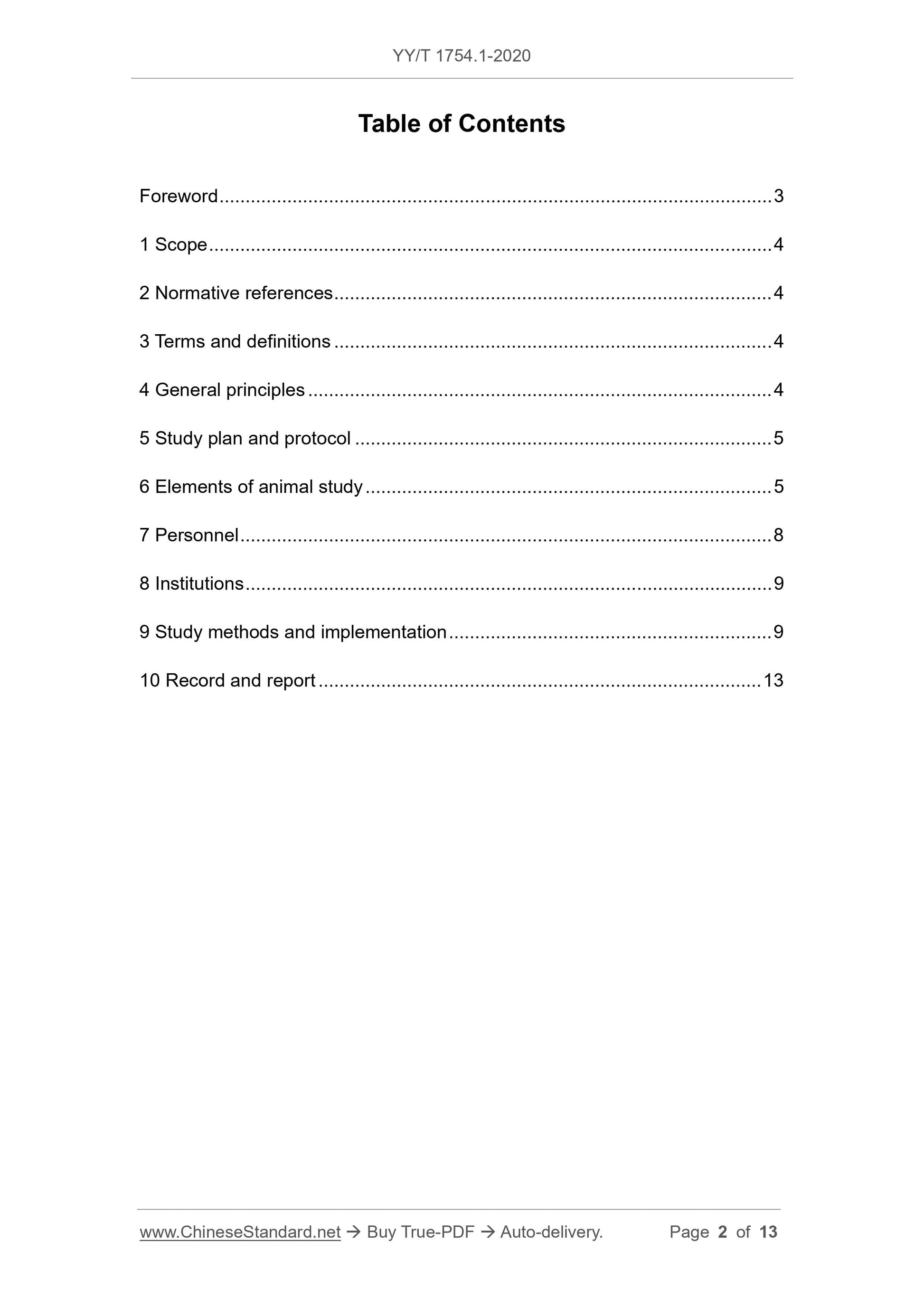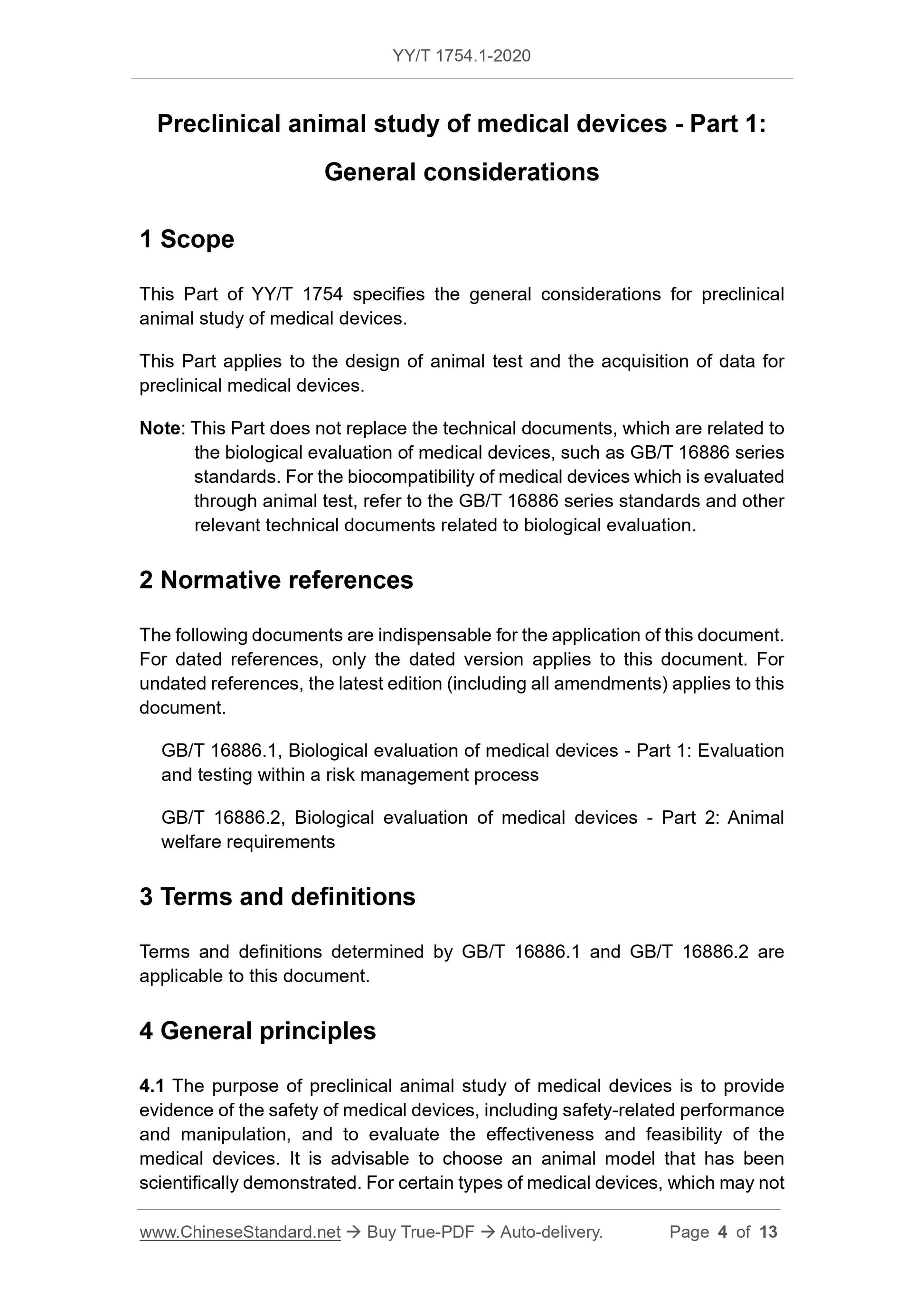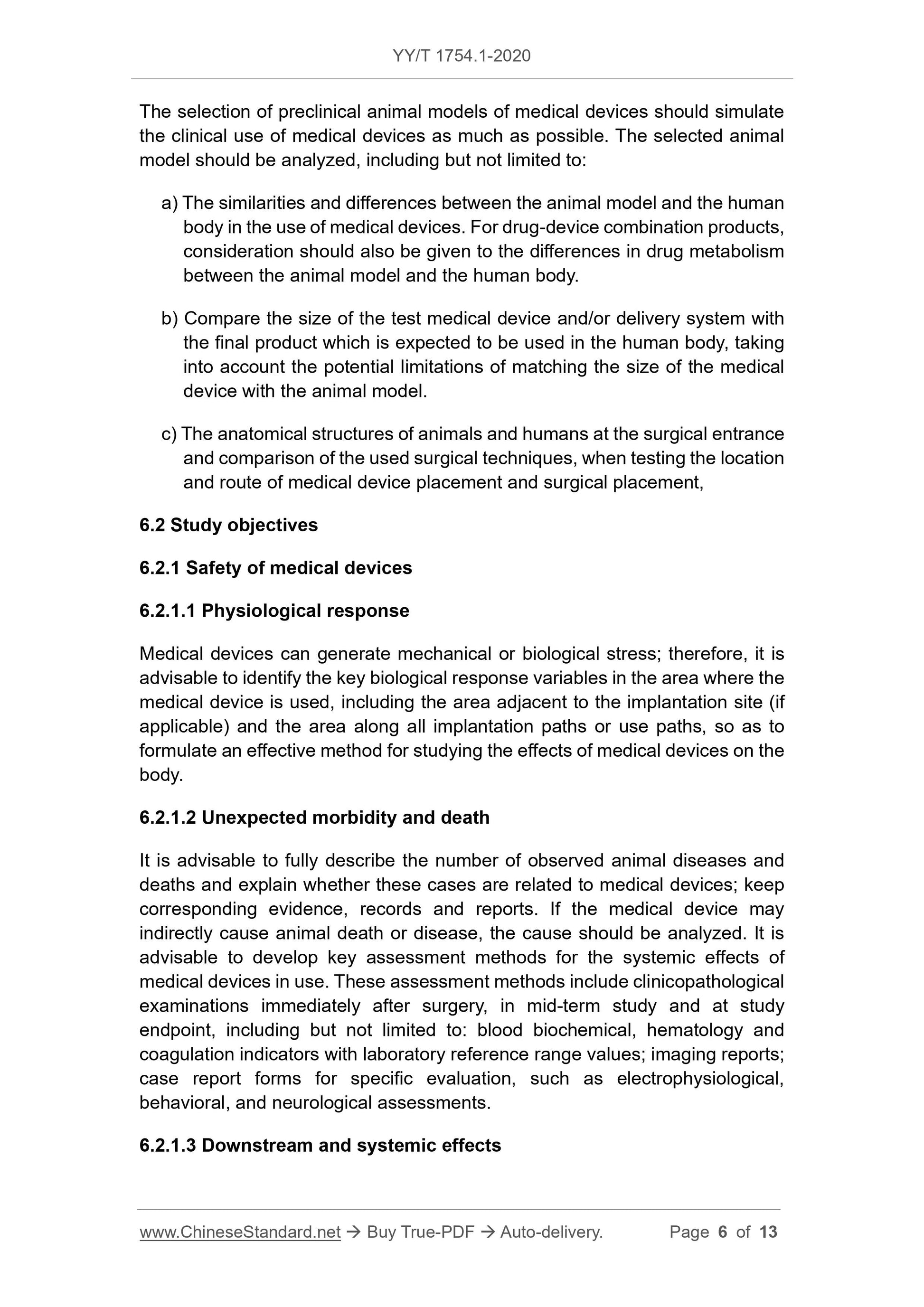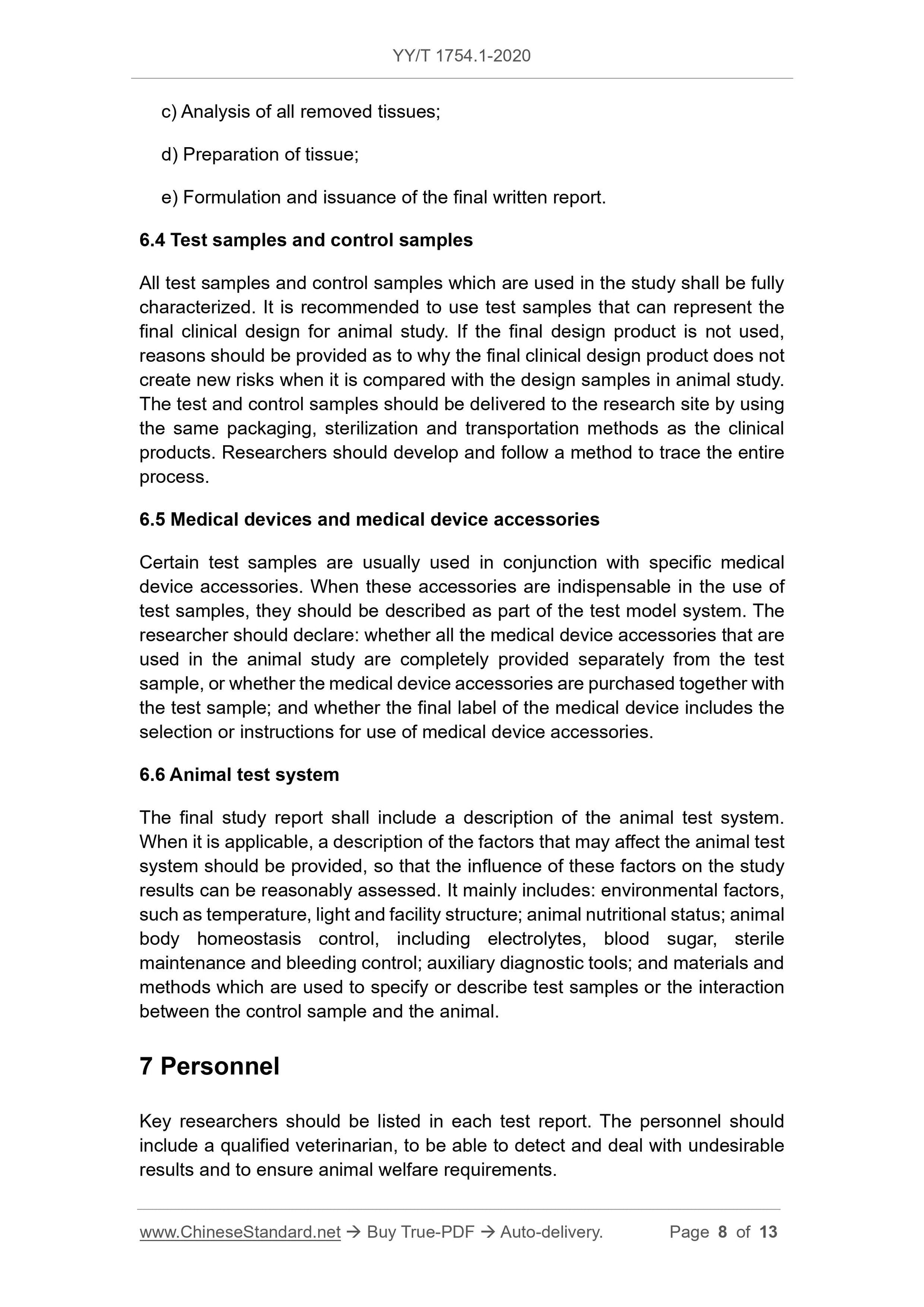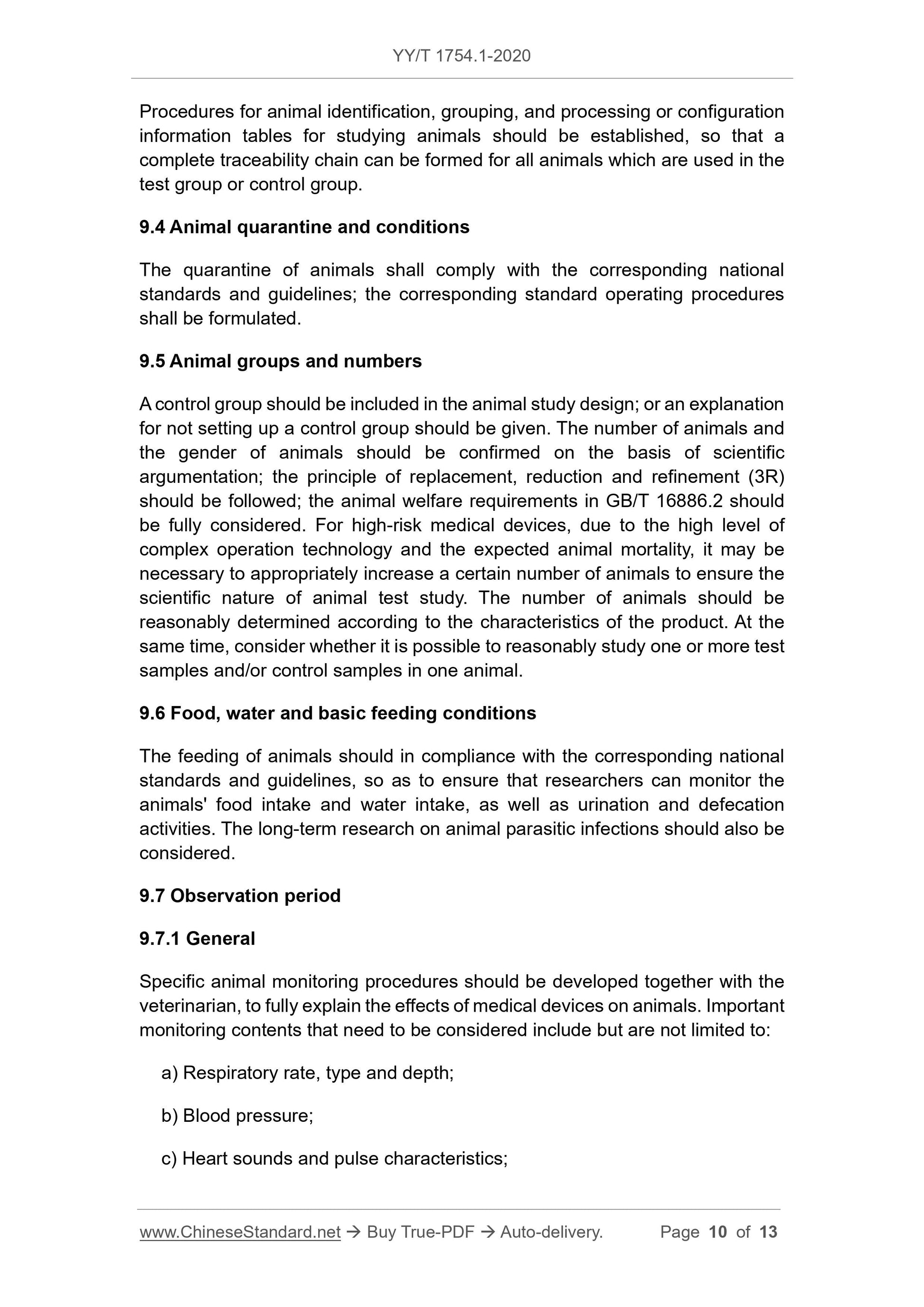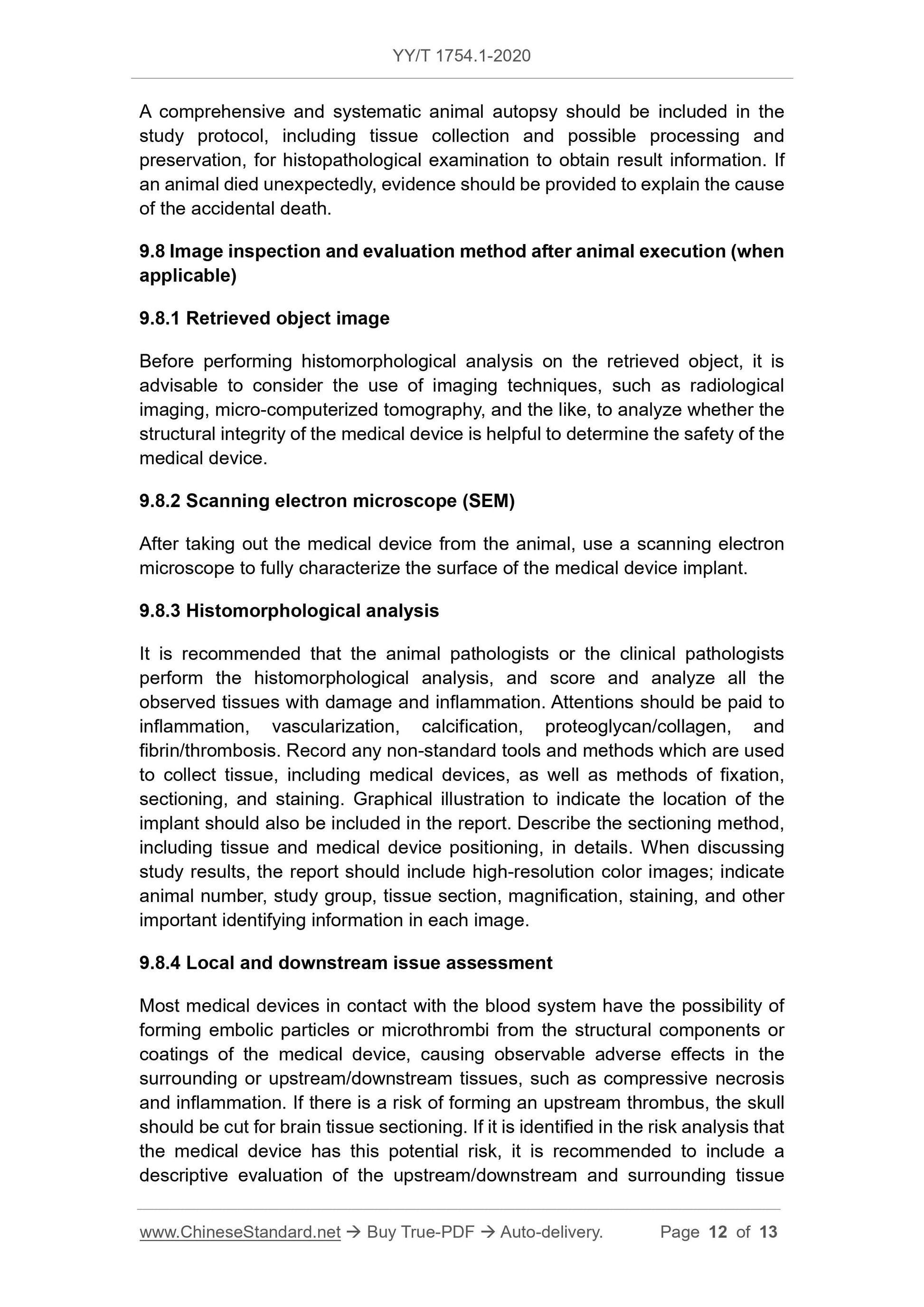1
/
of
7
PayPal, credit cards. Download editable-PDF & invoice in 1 second!
YY/T 1754.1-2020 English PDF (YYT1754.1-2020)
YY/T 1754.1-2020 English PDF (YYT1754.1-2020)
Regular price
$185.00 USD
Regular price
Sale price
$185.00 USD
Unit price
/
per
Shipping calculated at checkout.
Couldn't load pickup availability
Delivery: 3 seconds. Download true-PDF + Invoice.
Get QUOTATION in 1-minute: Click YY/T 1754.1-2020
Historical versions: YY/T 1754.1-2020
Preview True-PDF (Reload/Scroll if blank)
YY/T 1754.1-2020: Preclinical animal study of medical devices -- Part 1: General considerations
YY/T 1754.1-2020
YY
PHARMACEUTICAL INDUSTRY STANDARD
OF THE PEOPLE’S REPUBLIC OF CHINA
ICS 11.040.01
C 30
Preclinical animal study of medical devices - Part 1:
General considerations
ISSUED ON: SEPTEMBER 27, 2020
IMPLEMENTED ON: SEPTEMBER 01, 2021
Issued by: National Medical Products Administration
Table of Contents
Foreword ... 3
1 Scope ... 4
2 Normative references ... 4
3 Terms and definitions ... 4
4 General principles ... 4
5 Study plan and protocol ... 5
6 Elements of animal study ... 5
7 Personnel ... 8
8 Institutions ... 9
9 Study methods and implementation ... 9
10 Record and report ... 13
Preclinical animal study of medical devices - Part 1:
General considerations
1 Scope
This Part of YY/T 1754 specifies the general considerations for preclinical
animal study of medical devices.
This Part applies to the design of animal test and the acquisition of data for
preclinical medical devices.
Note: This Part does not replace the technical documents, which are related to
the biological evaluation of medical devices, such as GB/T 16886 series
standards. For the biocompatibility of medical devices which is evaluated
through animal test, refer to the GB/T 16886 series standards and other
relevant technical documents related to biological evaluation.
2 Normative references
The following documents are indispensable for the application of this document.
For dated references, only the dated version applies to this document. For
undated references, the latest edition (including all amendments) applies to this
document.
GB/T 16886.1, Biological evaluation of medical devices - Part 1: Evaluation
and testing within a risk management process
GB/T 16886.2, Biological evaluation of medical devices - Part 2: Animal
welfare requirements
3 Terms and definitions
Terms and definitions determined by GB/T 16886.1 and GB/T 16886.2 are
applicable to this document.
4 General principles
4.1 The purpose of preclinical animal study of medical devices is to provide
evidence of the safety of medical devices, including safety-related performance
and manipulation, and to evaluate the effectiveness and feasibility of the
medical devices. It is advisable to choose an animal model that has been
scientifically demonstrated. For certain types of medical devices, which may not
The selection of preclinical animal models of medical devices should simulate
the clinical use of medical devices as much as possible. The selected animal
model should be analyzed, including but not limited to:
a) The similarities and differences between the animal model and the human
body in the use of medical devices. For drug-device combination products,
consideration should also be given to the differences in drug metabolism
between the animal model and the human body.
b) Compare the size of the test medical device and/or delivery system with
the final product which is expected to be used in the human body, taking
into account the potential limitations of matching the size of the medical
device with the animal model.
c) The anatomical structures of animals and humans at the surgical entrance
and comparison of the used surgical techniques, when testing the location
and route of medical device placement and surgical placement,
6.2 Study objectives
6.2.1 Safety of medical devices
6.2.1.1 Physiological response
Medical devices can generate mechanical or biological stress; therefore, it is
advisable to identify the key biological response variables in the area where the
medical device is used, including the area adjacent to the implantation site (if
applicable) and the area along all implantation paths or use paths, so as to
formulate an effective method for studying the effects of medical devices on the
body.
6.2.1.2 Unexpected morbidity and death
It is advisable to fully describe the number of observed animal diseases and
deaths and explain whether these cases are related to medical devices; keep
corresponding evidence, records and reports. If the medical device may
indirectly cause animal death or disease, the cause should be analyzed. It is
advisable to develop key assessment methods for the systemic effects of
medical devices in use. These assessment methods include clinicopathological
examinations immediately after surgery, in mid-term study and at study
endpoint, including but not limited to: blood biochemical, hematology and
coagulation indicators with laboratory reference range values; imaging reports;
case report forms for specific evaluation, such as electrophysiological,
behavioral, and neurological assessments.
6.2.1.3 Downstream and systemic effects
c) Analysis of all removed tissues;
d) Preparation of tissue;
e) Formulation and issuance of the final written report.
6.4 Test samples and control samples
All test samples and control samples which are used in the study shall be fully
characterized. It is recommended to use test samples that can represent the
final clinical design for animal study. If the final design product is not used,
reasons should be provided as to why the final clinical design product does not
create new risks when it is compared with the design samples in animal study.
The test and control samples should be delivered to the research site by using
the same packaging, sterilization and transportation methods as the clinical
products. Researchers should develop and follow a method to trace the entire
process.
6.5 Medical devices and medical device accessories
Certain test samples are usually used in conjunction with specific medical
device accessories. When these accessories are indispensable in the use of
test samples, they should be described as part of the test model system. The
researcher should declare: whether all the medical device accessories that are
used in the animal study are completely provided separately from the test
sample, or whether the medical device accessories are purchased together with
the test sample; and whether the final label of the medical device includes the
selection or instructions for use of medical device accessories.
6.6 Animal test system
The final study report shall include a description of the animal test system.
When it is applicable, a description of the factors that may affect the animal test
system should be provided, so that the influence of these factors on the study
results can be reasonably assessed. It mainly includes: environmental factors,
such as temperature, light and facility structure; animal nutritional status; animal
body homeostasis control, including electrolytes, blood sugar, sterile
maintenance and bleeding control; auxiliary diagnostic tools; and materials and
methods which are used to specify or describe test samples or the interaction
between the control sample and the animal.
7 Personnel
Key researchers should be listed in each test report. The personnel should
include a qualified veterinarian, to be able to detect and deal with undesirable
results and to ensure animal welfare requirements.
Procedures for animal identification, grouping, and processing or configuration
information tables for studying animals should be established, so that a
complete traceability chain can be formed for all animals which are used in the
test group or control group.
9.4 Animal quarantine and conditions
The quarantine of animals shall comply with the corresponding national
standards and...
Get QUOTATION in 1-minute: Click YY/T 1754.1-2020
Historical versions: YY/T 1754.1-2020
Preview True-PDF (Reload/Scroll if blank)
YY/T 1754.1-2020: Preclinical animal study of medical devices -- Part 1: General considerations
YY/T 1754.1-2020
YY
PHARMACEUTICAL INDUSTRY STANDARD
OF THE PEOPLE’S REPUBLIC OF CHINA
ICS 11.040.01
C 30
Preclinical animal study of medical devices - Part 1:
General considerations
ISSUED ON: SEPTEMBER 27, 2020
IMPLEMENTED ON: SEPTEMBER 01, 2021
Issued by: National Medical Products Administration
Table of Contents
Foreword ... 3
1 Scope ... 4
2 Normative references ... 4
3 Terms and definitions ... 4
4 General principles ... 4
5 Study plan and protocol ... 5
6 Elements of animal study ... 5
7 Personnel ... 8
8 Institutions ... 9
9 Study methods and implementation ... 9
10 Record and report ... 13
Preclinical animal study of medical devices - Part 1:
General considerations
1 Scope
This Part of YY/T 1754 specifies the general considerations for preclinical
animal study of medical devices.
This Part applies to the design of animal test and the acquisition of data for
preclinical medical devices.
Note: This Part does not replace the technical documents, which are related to
the biological evaluation of medical devices, such as GB/T 16886 series
standards. For the biocompatibility of medical devices which is evaluated
through animal test, refer to the GB/T 16886 series standards and other
relevant technical documents related to biological evaluation.
2 Normative references
The following documents are indispensable for the application of this document.
For dated references, only the dated version applies to this document. For
undated references, the latest edition (including all amendments) applies to this
document.
GB/T 16886.1, Biological evaluation of medical devices - Part 1: Evaluation
and testing within a risk management process
GB/T 16886.2, Biological evaluation of medical devices - Part 2: Animal
welfare requirements
3 Terms and definitions
Terms and definitions determined by GB/T 16886.1 and GB/T 16886.2 are
applicable to this document.
4 General principles
4.1 The purpose of preclinical animal study of medical devices is to provide
evidence of the safety of medical devices, including safety-related performance
and manipulation, and to evaluate the effectiveness and feasibility of the
medical devices. It is advisable to choose an animal model that has been
scientifically demonstrated. For certain types of medical devices, which may not
The selection of preclinical animal models of medical devices should simulate
the clinical use of medical devices as much as possible. The selected animal
model should be analyzed, including but not limited to:
a) The similarities and differences between the animal model and the human
body in the use of medical devices. For drug-device combination products,
consideration should also be given to the differences in drug metabolism
between the animal model and the human body.
b) Compare the size of the test medical device and/or delivery system with
the final product which is expected to be used in the human body, taking
into account the potential limitations of matching the size of the medical
device with the animal model.
c) The anatomical structures of animals and humans at the surgical entrance
and comparison of the used surgical techniques, when testing the location
and route of medical device placement and surgical placement,
6.2 Study objectives
6.2.1 Safety of medical devices
6.2.1.1 Physiological response
Medical devices can generate mechanical or biological stress; therefore, it is
advisable to identify the key biological response variables in the area where the
medical device is used, including the area adjacent to the implantation site (if
applicable) and the area along all implantation paths or use paths, so as to
formulate an effective method for studying the effects of medical devices on the
body.
6.2.1.2 Unexpected morbidity and death
It is advisable to fully describe the number of observed animal diseases and
deaths and explain whether these cases are related to medical devices; keep
corresponding evidence, records and reports. If the medical device may
indirectly cause animal death or disease, the cause should be analyzed. It is
advisable to develop key assessment methods for the systemic effects of
medical devices in use. These assessment methods include clinicopathological
examinations immediately after surgery, in mid-term study and at study
endpoint, including but not limited to: blood biochemical, hematology and
coagulation indicators with laboratory reference range values; imaging reports;
case report forms for specific evaluation, such as electrophysiological,
behavioral, and neurological assessments.
6.2.1.3 Downstream and systemic effects
c) Analysis of all removed tissues;
d) Preparation of tissue;
e) Formulation and issuance of the final written report.
6.4 Test samples and control samples
All test samples and control samples which are used in the study shall be fully
characterized. It is recommended to use test samples that can represent the
final clinical design for animal study. If the final design product is not used,
reasons should be provided as to why the final clinical design product does not
create new risks when it is compared with the design samples in animal study.
The test and control samples should be delivered to the research site by using
the same packaging, sterilization and transportation methods as the clinical
products. Researchers should develop and follow a method to trace the entire
process.
6.5 Medical devices and medical device accessories
Certain test samples are usually used in conjunction with specific medical
device accessories. When these accessories are indispensable in the use of
test samples, they should be described as part of the test model system. The
researcher should declare: whether all the medical device accessories that are
used in the animal study are completely provided separately from the test
sample, or whether the medical device accessories are purchased together with
the test sample; and whether the final label of the medical device includes the
selection or instructions for use of medical device accessories.
6.6 Animal test system
The final study report shall include a description of the animal test system.
When it is applicable, a description of the factors that may affect the animal test
system should be provided, so that the influence of these factors on the study
results can be reasonably assessed. It mainly includes: environmental factors,
such as temperature, light and facility structure; animal nutritional status; animal
body homeostasis control, including electrolytes, blood sugar, sterile
maintenance and bleeding control; auxiliary diagnostic tools; and materials and
methods which are used to specify or describe test samples or the interaction
between the control sample and the animal.
7 Personnel
Key researchers should be listed in each test report. The personnel should
include a qualified veterinarian, to be able to detect and deal with undesirable
results and to ensure animal welfare requirements.
Procedures for animal identification, grouping, and processing or configuration
information tables for studying animals should be established, so that a
complete traceability chain can be formed for all animals which are used in the
test group or control group.
9.4 Animal quarantine and conditions
The quarantine of animals shall comply with the corresponding national
standards and...
Share
